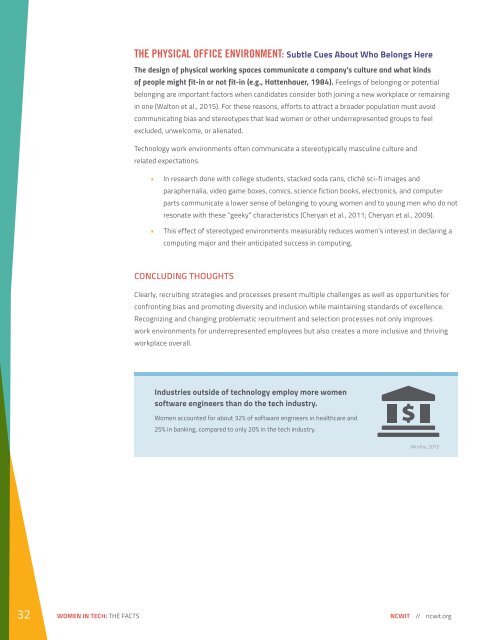WOMEN IN TECH THE FACTS
womenintech_facts_fullreport_05132016
womenintech_facts_fullreport_05132016
You also want an ePaper? Increase the reach of your titles
YUMPU automatically turns print PDFs into web optimized ePapers that Google loves.
<strong>THE</strong> PHYSICAL OFFICE ENVIRONMENT: Subtle Cues About Who Belongs Here<br />
The design of physical working spaces communicate a company’s culture and what kinds<br />
of people might fit-in or not fit-in (e.g., Hattenhauer, 1984). Feelings of belonging or potential<br />
belonging are important factors when candidates consider both joining a new workplace or remaining<br />
in one (Walton et al., 2015). For these reasons, efforts to attract a broader population must avoid<br />
communicating bias and stereotypes that lead women or other underrepresented groups to feel<br />
excluded, unwelcome, or alienated.<br />
Technology work environments often communicate a stereotypically masculine culture and<br />
related expectations.<br />
• In research done with college students, stacked soda cans, cliché sci-fi images and<br />
paraphernalia, video game boxes, comics, science fiction books, electronics, and computer<br />
parts communicate a lower sense of belonging to young women and to young men who do not<br />
resonate with these “geeky” characteristics (Cheryan et al., 2011; Cheryan et al., 2009).<br />
• This effect of stereotyped environments measurably reduces women’s interest in declaring a<br />
computing major and their anticipated success in computing.<br />
CONCLUD<strong>IN</strong>G THOUGHTS<br />
Clearly, recruiting strategies and processes present multiple challenges as well as opportunities for<br />
confronting bias and promoting diversity and inclusion while maintaining standards of excellence.<br />
Recognizing and changing problematic recruitment and selection processes not only improves<br />
work environments for underrepresented employees but also creates a more inclusive and thriving<br />
workplace overall.<br />
Industries outside of technology employ more women<br />
software engineers than do the tech industry.<br />
Women accounted for about 32% of software engineers in healthcare and<br />
25% in banking, compared to only 20% in the tech industry.<br />
Murthy, 2015<br />
32 <strong>WOMEN</strong> <strong>IN</strong> <strong>TECH</strong>: <strong>THE</strong> <strong>FACTS</strong> NCWIT // ncwit.org


